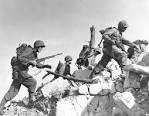
JAPANESE-HELD
OKINAWA UNDER U.S. ASSAULT
Easter Sunday-April 1, 1945
This 90-year-old man, Noah H. Belew, was a teenager when we invaded the island of Okinawa, and had been fighting Japanese on other Pacific Islands for about two years.
On this date in 1945, a cloudless Easter Sunday, 60,000 U.S. soldiers and Marines landed on Okinawa, launching Operation Iceberg. Overhead, ferocious attacks by these one-way airmen, or kamikaze, took a heavy toll in lives and damaged dozens of U.S. and British vessels that stood off the island. The kamikaze had been named after the divine wind that had, in medieval times, saved Japan from invasion. However at Okinawa kamikaze aviators loosed a new tactic against Allied ships offshore: not single kamikaze salvos but typhoons of hundreds of aircraft, including the newly developed Ohka manned missiles, descended on the fleet. Between April 1 and May 25, seven major kamikaze attacks were attempted, involving more than 1,500 planes flying from Kyushu, Shikoku, and Formosa. The Japanese called these one-way squadrons “Floating Chrysanthemums,” and nearly all the pilots were half-trained adolescents, some as young as seventeen. Many had never flown solo or landed an airplane.
In spite of Japan’s suicide offensive, which also included land-based motorboats, by the middle of April American forces had secured three-quarters of the Long Island-sized island with relative ease. By then much harder fighting had started on the so-called Shuri Line to the south. It took two and a half more months of grueling close-quarter fighting before Japanese resistance ceased. When it did, the largest land battle of the Pacific War had claimed nearly 40,000 American casualties, with over 100,000 dead on the Japanese side, including over 1,000 one-way pilots.




